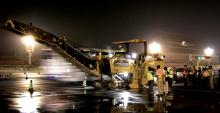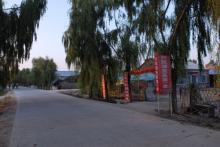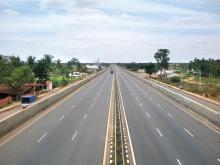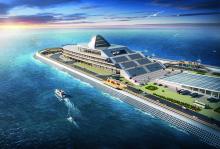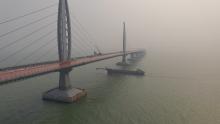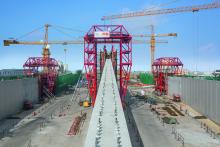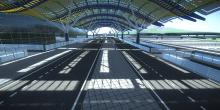China is still moving ahead with plans that will give it the world's biggest highway system. Patrick Smith reports. As China's economy grows even more, keeping the country on the move has become a priority for the government. While the country has made great strides over the past decade in improving its infrastructure, the number of vehicles has also increased rapidly, and in some instances restrictions have been placed on them.
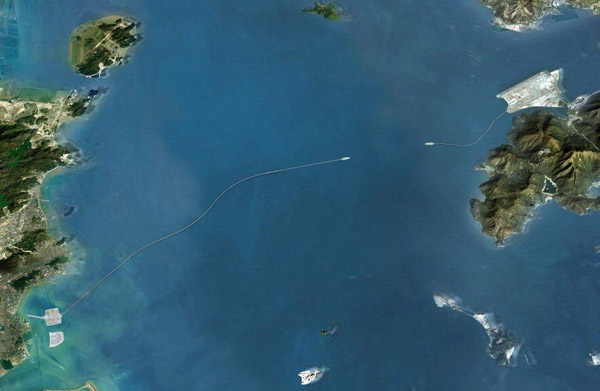
PICTURE: (c)HPDI/Cowi/ShanghaiTunnel/ First Harbour Engineering/ArupJV
China is still moving ahead with plans that will give it the world's biggest highway system. Patrick Smith reports
As China's economy grows even more, keeping the country on the move has become a priority for the government. While the country has made great strides over the past decade in improving its infrastructure, the number of vehicles has also increased rapidly, and in some instances restrictions have been placed on them.Many recall what has been described as the worst traffic jam in history, a 100km queue on the Beijing-Tibet highway in August, 2010, where drivers were help up for over 20 days. The cause of the chaos was hundreds of heavy trucks transporting coal from Inner Mongolia to power stations in the capital Beijing, with the lack of suitable rail links being blamed for the problems that lasted for nearly three weeks.
And as China overtook the US as the world's biggest car and van market in 2009, with 13.6 million vehicles sold within the country, late last year new rules that restricted car purchases were introduced to combat traffic problems in Beijing. City authorities say they will allow only 240,000 vehicles to be registered for 2011, one-third of the 2010 total. However, China is rapidly increasing its rail links along with its highways and the latest estimates are that it will complete an impressive highway network by 2020. Indeed, it is said that China is planning to add some 1.29 million km of road and 26,000km of expressway by that year.
Highway and infrastructure expansion is a key part of China's 12th Five Year Plan (2011-2015), and it is understood that the government is looking at a scheme involving two types of road networks to include the tolled expressways with low tariffs, and another without tolls.
The Plan also seeks to improve people's livelihoods, social infrastructure and safety nets, and to tackle rising inequality, with expanding domestic consumption seen by many as a key part of China's economic structural adjustment and achieving more balanced growth.
The country has also committed a reported $6.5 billion as part of a plan, involving other nations, to reconstruct the ancient Silk Road linking China with Europe while in another move it is also one of 32 countries that has signed an agreement for the construction of highways to span the continent and reach Europe.
Meanwhile, China's total expressway length increased from 41,000km to 74,000km during the Five-Year Plan ending in 2010, and new construction projects include building seven highways starting from Beijing, nine highways running north and south, and 18 running east and west.
It has been predicted that the total length of China's expressways length will pass that of the United States over the next five years: the US has the world's longest highway system. However, while China's economy strides ahead with high quality highways on the eastern seaboard, much needs to be done to improve the transport links in the mountainous regions of the west of the country.
All this work needs equipment, and according to the latest statistics, provided by BICES (the 11th Beijing International Construction Machinery Exhibition & Seminar), the major international construction equipment show held in the capital (see separate story), during its 11th National Five-Year Plan (2006-2010), sales of Chinese construction machinery increased from 162 billion yuan (US$25.37 billion) in 2006 to 436.7 billion yuan ($68.39 billion) in 2010, and eleven of China's enterprises moved into the top 50 of world construction machinery manufacturers, including
"A significant number of our customers are based in the Asia Pacific region, and we expect a substantial per cent of our business to flow through this centre in the next few years," said chairman Wang Xiaohua, chairman, Guangxi LiuGong Machinery Corporation.
LiuGong expects its Asia Pacific headquarters in Singapore to generate more than $50 million in revenues in the first year of operations, with expected annual growth rates of 30%. The office, which will serve south-east Asia, New Zealand, Papua New Guinea and other islands in Pacific.
"Since 2008, China has grown to be the biggest manufacturing base and most dynamic market of the construction machinery in the world," say the BICES 2011 organisers, pointing out that in 2010, China's import and export of machinery reached a total of $18.74 billion, a 45.7% increase over 2009. Imports at $8.4 billion showed a 63.2% increase over 2009, while exports amounted to $10.34 billion, a 34.2% increase over 2009.
"Trade surplus is $1.94 billion, down 24% on 2009," says BICES 2011.
Of the machines sold, the main export products are excavators, loaders, bulldozers, graders, road machinery, road rollers, asphalt mixing plant, truck cranes, all-terrain cranes, tower cranes, crawler cranes, electric forklifts, internal combustion forklifts, concrete drag pumps, concrete mixer trucks, concrete pumps, elevators and escalators.
Product sales totalled 1,107,554 units in 2010, and included excavating machinery (179,296 total sales), loaders (228,219), bulldozers (13,911), graders (4,531), tower cranes (43,400), forklifts (232,409), rollers (26,281), pavers (3,109), asphalt mixing plants (800), and road milling machines (500).
In the first half of 2011, sales of loaders totalled 140,918 along with bulldozers (8,814), graders (2,898), cranes (23,365), vehicles (161,935), rollers (14,238), pavers (2,332) and excavators (124,650).
In a recent interview on China's highway system, quoted in Money Morning, the publications' chief investment strategist Keith Fitz-Gerald said: "China is building the largest road network in the world. It's a numbers game that's going to support cars, buses and all forms of trucking for years to come, together with their underlying suppliers." Only recently as part of this push, China opened the world's longest bridge over water, the 41.58km Jiaozhou Bay Bridge, which is said to have cost well over US$2 billion to build, although it only likely to hold the record for a few years.
Linking the eastern port city of Qingdao to Huangdao Island across Jiaozhou Bay it is expected to carry some 30,000 vehicles/day and will reduce travel time by 30 minutes.
However, with construction of the 50km, dual three-lane sea bridge linking China's southern Guangdong province with the islands of Hong Kong and Macau (Hong Kong-Zhuhai- Macao Bridge), the Jiaozhou Bay Bridge will lose its record in 2016, when the project is scheduled for completion.
The $10.7 billion Hong Kong-Zhuhai- Macau Bridge project will connect two huge regions and will be the first major combined bridge and tunnel sea-crossing project in China, reducing travel time from Hong Kong to Macau or Zhuhai from over three hours to just half an hour helping to boost logistics and tourism development in the region.
It is considered a vital link to prosperity in the Pan-Pearl River Delta region. Among those involved in bridge and tunnel design, as well as the design of the artificial island foundations is
A 38km bridge in the South China Sea will form a fixed crossing over the Pearl River estuary between Zhuhai and Macau on the western side and Hong Kong on the eastern side. The 29.6km main section is in Zhuhai waters and comprises 22.8km of bridge work including three cable-stayed bridges with spans ranging from 280m to 460m; viaducts spanning 75m and 110m, a 6km tunnel and two artificial islands.
Work has also started on a key a bridge link in China's Shandong's Dongming County, which will take four years to construct. Once complete the bridge will provide a link between Changyuan County in Henan Province and Dongming County in Shandong Province.
The 23.5km bridge deal is worth some $604.22 million and the project will be carried out on a build-operate-transfer basis (BOT).
Shandong Jean Goujion Investment Group will contribute the project capital, which accounted for 35% of the total investment value, while the remaining amount will be sought in loan form from local banks.
Meanwhile, in China's Guangdong province, work on Heyuan city's first citylevel highway is due to start in December. The 37.3km east ring highway will connect Dongyuan County and Zijin County. Dongguan Jilong Group will invest in the project, which is due for completion in 2014.
The highway will have 11 tunnels and 43 bridges.


